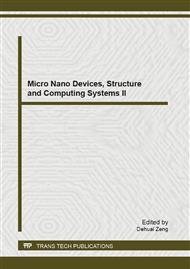p.3
p.9
p.16
p.20
p.25
p.31
p.36
p.42
The Electrical Characteristics Induced by B+ Doping of Nanotube MOSFET
Abstract:
In this paper, we not only discuss the effect of doping concentration to conductivity but also some other factors. Such as the thickness of SiO2 and the resistance of the conductive part (Si shell). And we have got the consequence that the higher the doping concentration is, the higher conductivity. The reason is that doping increased carrier concentration and then increased µ. The thicker the Si shell is and the shorter lengths the nanotube has, the smaller resistance the conductive part has and the higher conductivity. About the thickness of SiO2, the situation is a little more complex. As a p-channel FET. When Vg>0, the thicker the SiO2 is, the higher conductivity. When Vg2 is, the higher conductivity. As a n-channel FET, the situation is opposite. The reason is about potential barrier height and the location of EF. At last we repeated the previous research work and have more optimization in a reasonable parameter range. The results demonstrate that we can control conductivity and reach high transport properties for core/shell nanocable MOSFETs by combination with multiple methods.
Info:
Periodical:
Pages:
20-24
Citation:
Online since:
March 2013
Authors:
Keywords:
Price:
Сopyright:
© 2013 Trans Tech Publications Ltd. All Rights Reserved
Share:
Citation:


